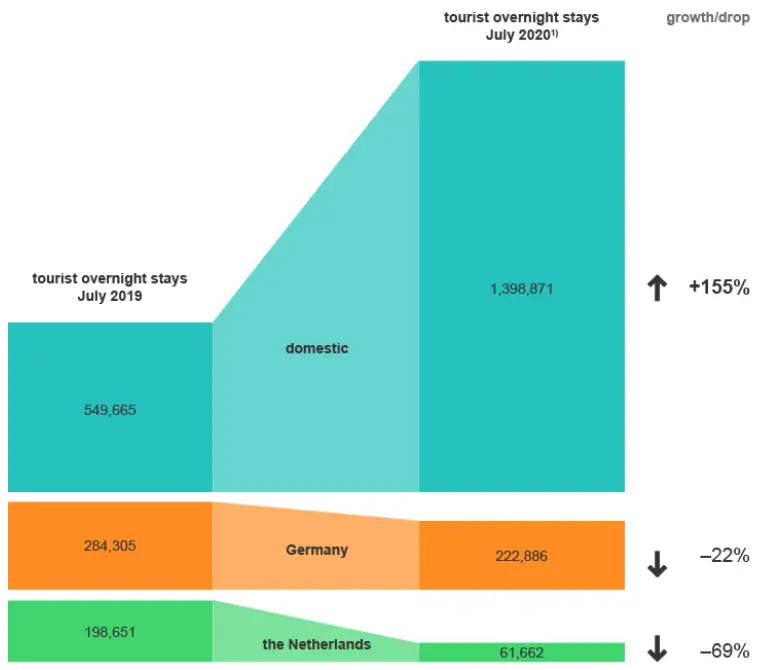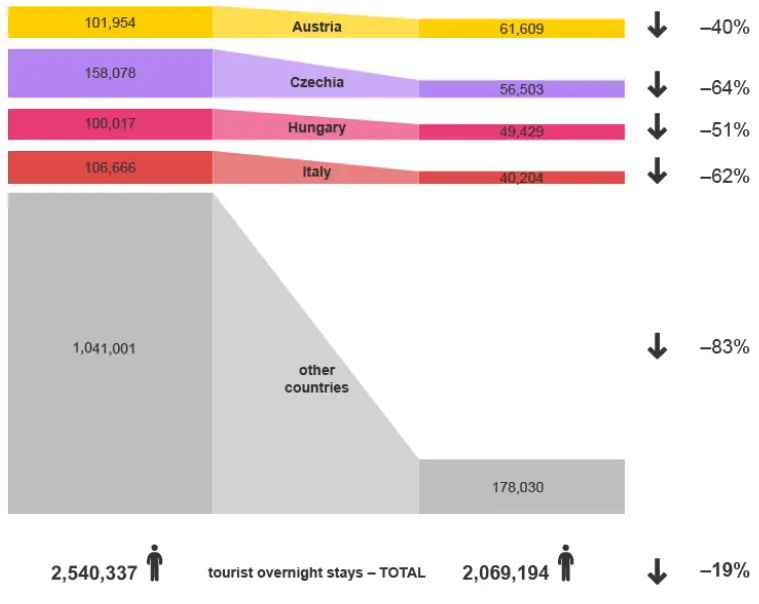Ljubljana related
The tourism and hospitality industry was uniquely affected by the pandemic. We were left without visitors, bookings, and any sign of returning to normal. The good news is that visitors are coming back. The World Travel and Tourism Council (WTTC) anticipates tourism could contribute $8.6 trillion USD to the global economy this year. This is just below pre-pandemic levels.
Imagine international tourists taking a road trip through Slovenia and after a long day they want to find a place to stay the night and somewhere to eat. They will most likely use their phones to search for nearby accommodation or food recommendations.
If presented with two options on Google, where one is using their Google Business Profile to provide weekly updates and allow customers to leave glowing reviews, while the other never even claimed their profile and have no photos to show that they still exist. It should be no surprise that the business with content and social proof is more likely to be chosen.
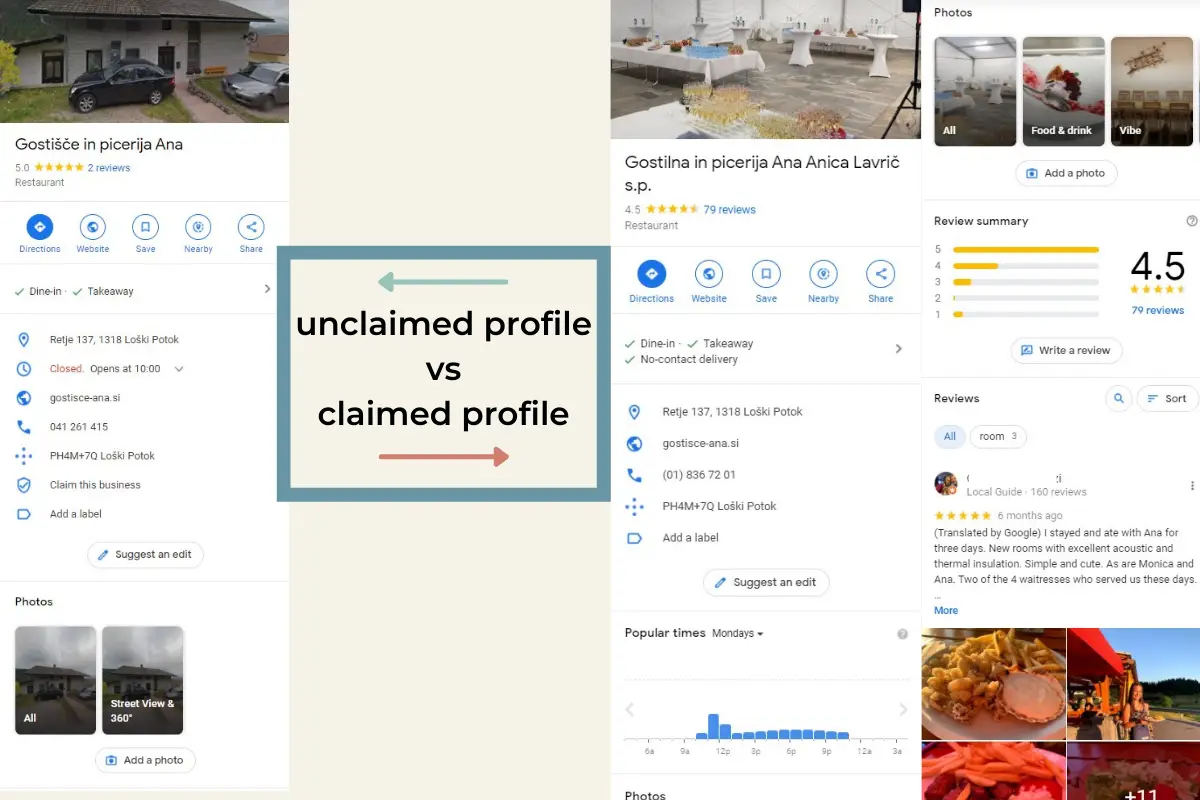
Besides which one the customer will choose, the businesses with claimed profiles and fresh content are rewarded with better real estate on Google Maps and search results.
In 2021, searches for “along my route” increased 1000%.
Tourists are more tech savvy than previously which means businesses need to digitize and get online.
Wallflower Studios is hosting a series of free webinars in 2022 to help support Slovenian-based businesses in the industry. The first of which will cover Google Business Profile; the benefits, how to set up your account, and how to use it to attract new customers.

Google Business Profile (previously Google My Business) is a free tool that can truly benefit your business when used strategically.
The webinar will take place on 2 different days to accommodate different schedules. When registering please use this Google Form and select your preferred date; Thursday 24 Feb (19:00) or Saturday 26 Feb (10:00).
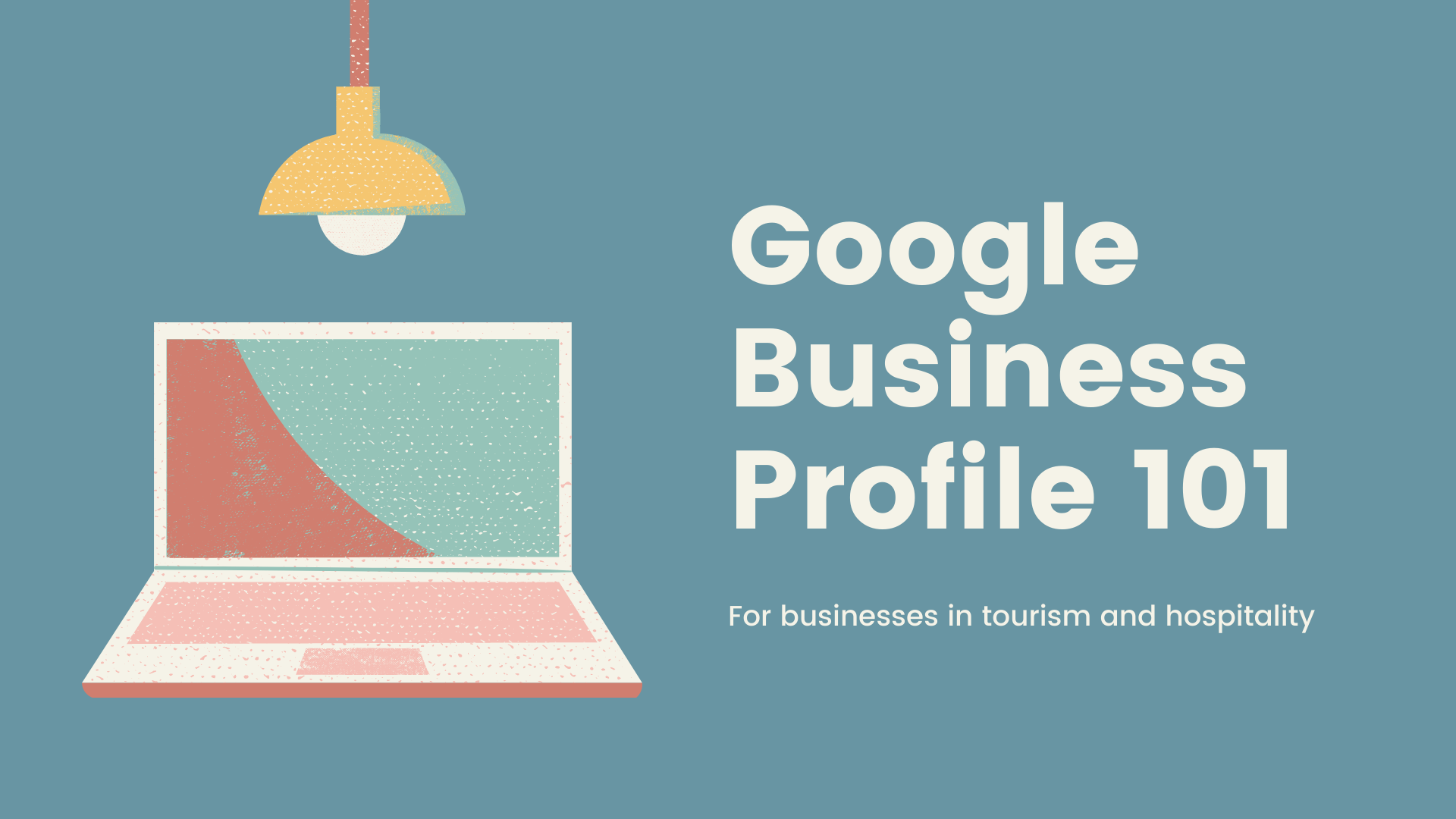
Visit Wallflower Studio’s official site for more details.
STA, 17 June 2021 - The government has passed an emergency law to help the embattled tourism sector. The package is worth EUR 243.5 million, with new tourist vouchers accounting for the bulk of new spending. Businesses think the aid falls short.
All adults residing in Slovenia as of 30 June will get a EUR 100 voucher to spend on activities ranging from tourism and restaurants to sports and culture. Those under 18 will get vouchers worth EUR 50. The total value of the vouchers is EUR 192 million.
Last year adults got tourism vouchers worth EUR 200 each and children EUR 50 each redeemable at accommodation providers, a package worth almost EUR 357 million. As of mid-May, EUR 130 million in vouchers had been redeemed.
The second principal measure is a package of furlough subsidies for the sector worth EUR 20m from 1 July, when the national furlough scheme expires, until 30 September, with the option of expansion until the end of the year.
Other measures in the new bill include subsidised holiday allowance, refunds of expenses for the convention industry, and a 25% refund of expenses for film and audiovisual production.
Additional money for the sector will also come from EU funds. Monika Kirbiš Rojs, state secretary at the Government Office for Development and European Cohesion Policy, told an event today that EUR 127 million in grants would be available for tourism investments under the national recovery and resilience plan.
"We're one of the few member states that decided to invest in tourism and culture. These two industries have suffered substantial damage during the Covid-19 pandemic and had not had sufficient investments in the past. We want to make up for that," she said.
Businesses voiced disappointment with the legislation, noting that they had expected much more given how the sector has suffered through the pandemic.
The Chamber of Trade Crafts and Small Business (OZS) said the legislation fell short as several measures that had been discussed with them did not make the cut.
"We appeal to the government to include certain aid instruments that we had been promised," OZS president Branko Meh said in a press release.
The Slovenian Business Club aired similar grievances, stressing that the sector remained subject to certain restrictions that no longer apply to most businesses after it had been shut down longer than any other sector.
"We agree that measures cannot last unreasonably long ... But we must now forget that not all industries and companies are in the same position and have not been equally affected by the epidemic," it said.
Commenting on the criticism, Economy Minister Zdravko Počivalšek said it was true that "some of our measures" did not make the cut, but he stressed that the government had to be mindful of the state of public finances.
He also said that many previous measures had significantly helped the industry. "In total, we will have provided nearly a billion euro in aid to the industry," he wrote on Twitter.
The Slovenian Tourist Board (STB) has announced that the country is now ready to welcome tourists once again, and is thus stepping up promotional activities to gain more of the much-anticipated post-epidemic boom in travel, as people rush beyond the boundaries set by restrictions to limit the spread of COVID-19 in the wake of the successful roll-out of vaccination programmes.
While anyone arriving now will still face limits with regard to where they can stay, with hotels allowed to offer no more than 30 rooms, and where they can eat and drink, with indoor dining still involving distancing, things do seem to be moving in the right direction.
STB is playing to Slovenia’s strengths when it comes to post-epidemic travel, promoting the great outdoors along with the exercise, fresh air and general healthy living that go with it.
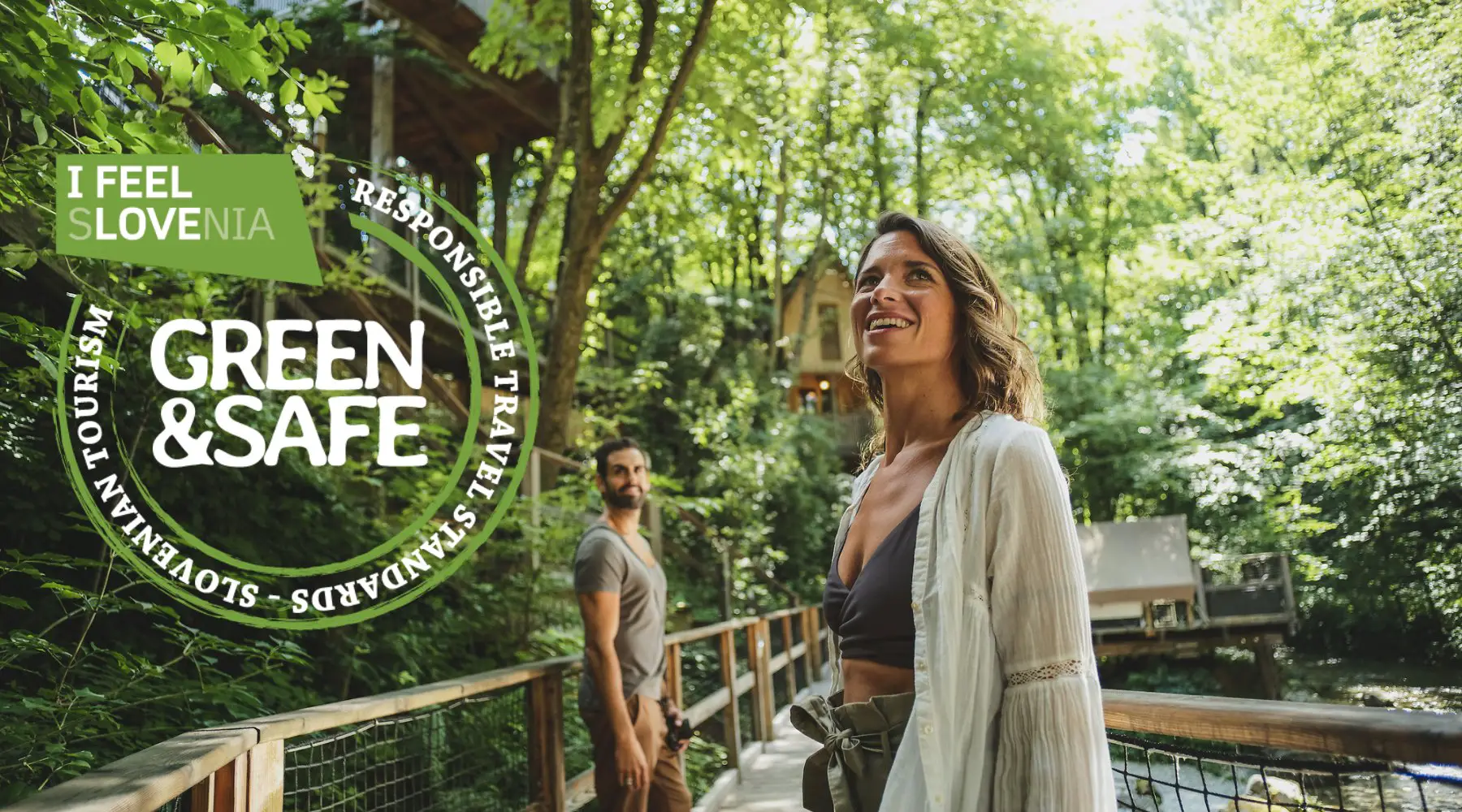
As Maja Pak, director of the STB, puts it:
The first steps towards the resumption of tourism give us hope for a quick re-establishment of tourist flows and the recovery of tourism as one of the most important industries. Throughout the crisis, the Slovenian Tourist Board has carried out situation-adapted communication activities on foreign and domestic markets, which have now been upgraded and strengthened, as the restrictions have released. In the light of changed travel habits, guests are in search of a non-mass, healthy and safe holiday destinations. Therefore, active experiences in unspoiled nature are being highlighted, a tourist product that has the most potential for the recovery of tourism.
Health is becoming an increasingly important value as well, so we also pay special attention to the product health and well-being. Slovenia is also the holder of the European Region of Gastronomy 2021 title, which means that we also focus on inviting domestic as well as foreign guests to discover unique gastronomic experiences. Of course, safety plays a major role when choosing a holiday destination, this is why Green&Safe brand has been launched, which present safe and attractive experiences in Slovenia.
In addition to foreign visitors, STB is also promoting staycations among Slovene’s with the Zdaj je čas. Moja Slovenija (The Time is Now. My Slovenia).
Anyone thinking of making a trip to Slovenia in the near future is advised to check out this website which has a good summary of the various criteria you need to meet in order to cross the border and avoid quarantine, with even more details provided here if needed.
There’s also an online app – in English – to guide you through the various restrictions. Just click here then scroll down to start the process, and find out if you’ll be able to enjoy a stay on the sunny side of the Alps.
STA, 21 February 2021 - Domestic tourists are expected to spend the rest of tourists vouchers, dominate this year's tourist season in Slovenia and make for the bulk of tourist nights, a survey into travel trends of Slovenians in 2021 shows.
"This year we expect the tourist vouchers to be again a big success after they saved our season in Bohinj last year," said the author of the survey, Anže Čokl, the head of two hotels from the area around the Alpine lake of Bohinj, north-west.
The number of foreign tourists will meanwhile heavily depend on vaccination rates, which will be key to restrictions easing, border reopening and an air travel rebound.
Domestic and foreign experts expect tourism to first recover at the local level where destinations can be reached by car.
Tourists are expected to book shorter holidays and closer home, while domestic tourists will expect to get even more for their money, the survey shows.
The problem are foremost destinations which are tightly linked to large groups from more distant parts of the world, such as Asia, Čokl explained.
However, as soon as it is possible, people will get back to old travel ways.
High hygiene standards are meanwhile there to stay and will play a major role in choosing accommodation, there should also be a rise in boutique accommodation and interest in less visited destinations.
With all hotels closed during the epidemic, there is a bit more time for education and preparations for next season, so I was interested to learn what Slovenian experts expect from this year's summer season, Čikl explained the motivation behind the survey. He thus talked to hotel directors, tour operators, researchers and other experts.
He said the structure of tourists in Bohinj completely changed last year, with the number of Slovenian tourists up from 8% in the pre-coronavirus year 2019 to 90%.
"Slovenians are good guests, but have different habits and the manner of travel than tourists from abroad."
The experience at Bohinj Eco Hotel shows that they like to spend much more time outdoor, while staying in Bohinj fewer days than foreigners, only 2-3 as opposed to 5-7.
Although he is not worried about the summer season, the problem is the events industry, a source of revenue in autumn and spring, which the pandemic has severely hit.
"When it comes to recovery in business events, we are unfortunately talking about years, not months," Čokl said.
STA, 1 February - After a very rough year that saw the coronavirus pandemic halve tourist arrivals, Slovenia's tourism sector is in for another demanding year in 2021. However, the country holds the title the European Region of Gastronomy this year, bringing hope that the sector will once again be able to open.
This year, the Slovenian Tourism Board (STO) included restaurateurs in its scheme with the sign Slovenia Green Cuisine.
Being the European Region of Gastronomy, Slovenia has great potential due to its quality local ingredients, tradition and creativity, an online press conference on Monday heard.
But in 2020, Slovenia's tourism sector found itself at the same level as it was 10 years ago, Maja Pak, the director of the STO said.
Recovery will take a long time, she said, estimating that the figures recorded in 2019 could be reached only around 2024.
The situation is not expected to improve much this year, albeit more foreign guests are expected, whereas their numbers plummeted in 2020, while the number of domestic guests increased by about 20% over 2019.
Data by the European Travel Commission show that Slovenia and Denmark were the only two European destinations that recorded an increase in the overnight stays of domestic guests in 2020.
Vaccination inspires hope for the future, however it is still key that tourism businesses survive until guests return, said Simon Zajc, state secretary at the Economy Ministry.
"True recovery will only be possible when international transport is relaunched and restrictive measures are lifted both in Slovenia and abroad," he added.
He believes that the mitigation measures by the government aimed at helping companies survive had gone a long way in helping to preserve jobs in the sector. Among others, he highlighted the extension of the tourism voucher scheme.
Expressing hope that accommodation facilities will be able to open soon, he did however not wish to speculate when this could be.
STA, 29 January 2021 - Slovenia recorded slightly over three million arrivals of domestic and foreign tourists in 2020, down by almost 51% on 2019, as a surge in domestic tourism failed to offset the collapse in foreign tourist arrivals, show data released by the Statistics Office on Friday.
Slovenian tourist accommodation facilities saw a 21% increase in domestic arrivals at the annual level with their overnight stays rising by 33%.
The arrivals of foreign tourists were down by 74%, whereas the overnight stays by them dropped by 71% on 2019.
Out of the foreign overnight tourists most came from Germany (almost 25%), followed by Austrians and Italians (11% each), Croatians (7%), Hungarians and the Dutch (each 5%).
The arrivals of both foreign and domestic tourists were down by 97% year-on-year in December, to just 9,300, and overnight stays plunged by 91%, as the lockdown shut down virtually the entire tourism sector.
Foreign tourists that spent the most nights in Slovenia in December came from Bosnia-Herzegovina, Serbia and Croatia.
STA, 8 December 2020 - Slovenian tourism is preparing for long-term recovery after the Covid-19 pandemic. The recovery plan will span until the end of 2023, with tourism resilience being strengthened for years to come, the central annual event in the sector heard. Economy Minister Zdravko Počivalšek thinks that the sector will return to record-breaking results.
This year's virtual Days of Slovenian Tourism revolves around response efforts in the wake of the coronavirus crisis.
Počivalšek noted at Tuesday's event that the number of tourists in Slovenia in the first ten months of 2020 dropped by 46% and the number of overnight stays by 37% compared to the same period in 2019.
When it comes to foreign tourists, the number of arrivals plunged by 72% and the number of overnight stays by 69%.
By the end of October, almost 6,000 tourism workers registered as unemployed at the Employment Service. Moreover, many are furloughed.
Počivalšek also pointed out that numerous tourism companies had pushed back investments due to the precarious situation.
"A longer recovery period is expected, perhaps even five years," he said, highlighting that tourism would need extensive support from the state and EU.
He vowed additional aid for the hospitality and tourism sectors and the meeting industry in the emerging seventh stimulus package.
Domestic tourism consumption will continue to be boosted by tourism vouchers, whose validity has been extended until the end of 2021, he said.
The way forward will be outlined in the 2020-2023 recovery plan. Shareholders are also coming up with projects to draw on EU funds.
Počivalšek expressed optimism regarding EU financial instruments designed to help the sector after the pandemic and said that depending on the epidemiological situation, Slovenia's partial lockdown could be eased by reopening facilities in the tourism and hospitality sectors among other things.
He believes that Slovenia's tourism will be again breaking records and bagging achievements.
Slovenian Tourist Board (STO) boss Maja Pak presented updated tourism forecasts for this year. The organisation is a bit less optimistic given the worsened epidemiological status at the end of the year as it was in late summer.
Until the end of 2020, the STO expects a 51% decrease in the number of tourists, including a 74% drop in the arrival of foreign tourists.
The number of overnight stays is expected to decrease by 42% on 2019. "This means that this year we will lose seven million overnight stays due to the pandemic," she said.
Next year is forecast to deliver similar figures. The STO anticipates a bit more foreign guests and somewhat fewer Slovenian tourists.
The number of tourists from abroad is expected to rise in years to follow, boosting tourism growth.
The recovery plan is based on several phases. The first-response phase is to be followed by the recovery phase, which is to last until the end of 2023.
The second phase will focus on the domestic market as well as neighbouring or nearby markets. Public calls as well as public health measures will be adjusted.
The third phase will focus on strengthening resilience, running until 2026. Restructuring and development of tourism infrastructure will be in focus.
Tourism will have to be at the heart of the national recovery and resilience plan, Pak said, adding that sustainable and digital development should be key.
She highlighted, among other things, re-establishment of air links, business tourism and investments as future challenges.
When tourism is relaunched, there will be many rivals, the STO boss noted, adding that Slovenia was at an advantage since it had been investing in sustainable or boutique tourism for years.
Andrej Prebil, the head of the Tourism and Hospitality Chamber (TGZS), meanwhile urged the government to draw up a separate stimulus package for tourism that would include all segments of the industry.
Additional funds for the STO are also necessary, he said, describing the organisation as the cornerstone of Slovenian tourism promotion.
Prebil believes at least EUR 10 million would be needed for recovery. Maintaining Slovenia's status as a green, active and safe country among foreign and domestic tourists is key, he added.
STA, 19 November 2020 - The services sector has been heavily affected by the Covid-19 epidemic. In Slovenia, the biggest monthly drop in services income was recorded in April, a 18.4% decrease. Pub, restaurant or cafe owners and travel agencies were hit worst in the months following the first epidemic declaration, a Statistics Office study shows.
Following the April drop, income figures were rising for three consecutive months and in July they were higher by 6.6% on June. However, services income dropped again in August, this time by 2% on the month before.
The August figure also indicated a 10.7% decrease year-on-year, a smaller drop compared to downward trends at the annual level in the first months after the epidemic was declared in March - for example, in April, the year-on-year drop was 28.9%.
Restaurants, bars and cafes closed in mid-March and some of them were open again for business in early May. Food deliveries and take-aways were their only options in the lockdown period.
Their income in March was already lower by 57.7% compared to February and they recorded a 62.4% monthly drop in April, the study, released on Thursday, shows.
In May, when restrictions were mainly lifted, the figure increased by 214.9% on April, however it was still 45.1% below the figure recorded in May 2019.
The summer months brought some relief, but income was still reduced by 10%-20% compared to the same period in 2019.
Travel agencies or other travel-related services have had it even worse though, having suffered the biggest decrease in income in the services sector. They recorded a 71.7% monthly drop in March and a 83% decrease month-on-month in April.
Following May the situation improved, however a year-on-year analysis again shows that 2020 has been a difficult year for them. The biggest annual drop was recorded in April - by 95.5% and during the May-August period year-on-year decreases were always above 70%.
The study provides further data indicating that Slovenian tourism was completely crippled in March and April. Between mid-March and mid-May there were none tourist arrivals and virtually zero overnight stays.
In June, the numbers of arrivals and overnight stays were at some 35% of the figures in June 2019.
Accommodation services recorded a 78.1% monthly drop in April. In June, the figure rose by 185.8% on May, likely due to the government measure introducing holiday vouchers, however it was still reduced by 60.8% on June 2019.
When it comes to annual comparisons, a Covid-related drop in income was less significant in summer. In July, the year-on-year decrease was 21.8% and in August 15.8%.
All our stories on Slovenia and covid
STA, 10 September 2020 - US luxury and lifestyle travel web portal Conde Nast Traveler has picked Slovenia as the top holiday destination for 2021. Tucked between old favourites Italy and Croatia, Slovenia offers Michelin-starred food, excellent wine, turquoise rivers, glacier-fed lakes and soaring, snow-capped peaks, it says on its web site.
The country's most famous landmark, Lake Bled, is described as being "more peaceful than any of Europe's better-known lakes". "For now, at least, it remains blissfully unbusy; a place of wide-open spaces, splendid solace and restoratively pristine air."
Conde Nast Traveler further highlights the country's cuisine and wine, and the Michelin-starred restaurants - Hiša Franko led by chef Ana Roš and the Strelec restaurant at Ljubljana Castle.
Slovenia is followed on the list of best places to visit in 2021 by England's Yorkshire, Portugal's Melides, the United Arab Emirates and Canary Islands.
You can read the full article here
STA, 25 August 2020 - The Slovenian tourism industry, which has been severely affected by the Covid-19 epidemic, saw an upbeat trend in Slovenian tourist arrivals and nights in July, partly offsetting the low numbers from the first half of the year, show the latest figures released by the Statistics Office on Tuesday.
Over 653,000 arrivals were recorded at accommodation facilities in July, down 27.5% compared to July 2019, with the number of nights down by 18.5% to 2.07 million.
However, the number of Slovenian tourists in the overall number increased by 176% to almost 404,000, and the number of nights they spent there by 155% to nearly 1.4 million.
The number of foreign arrivals meanwhile dropped by 67% to slightly over 249,300, and the number of nights they spent in Slovenia by 66% to over 670,300.
Germans spent the most nights in Slovenia in July, or 33%, followed by the Dutch and Austrians (9% each), Czechs (8%) and Hungarians (7%).
The most popular areas for tourists, domestic and foreign, were mountainous areas, which accounted for 35% of all tourist nights, followed by the coast (29%).
Thirty percent of all nights were made at hotels, 27% at private rooms, self-catering units and houses, and 22% at camping sites.
Although several areas in Slovenia have had a good summer season, Slovenian tourism has been considerably affected by the epidemic, with facilities in full lockdown for several weeks.
The January-to-July period saw almost 1.6 million tourist arrivals, a 54% drop compared to the same seven-month period in 2019. Tourist nights meanwhile dropped by 48% to around 4.6 million.
In the first half of the year, arrivals by Slovenian tourists dropped by 5% but a 2% rise was recorded in nights generated by domestic guests compared to January-July last year. The number of foreign tourists arriving in Slovenia plummeted by 71% and the nights they generated by 68%.
The figures are in line with the Slovenian Tourist Board's projections of a 70% drop in foreign arrivals for the year and of a 50% overall drop because of a rise in domestic tourists.
To help the industry survive, the government introduced a special voucher scheme, giving every permanent resident EUR 200 to spend in Slovenia until the end of the year on bed and breakfast, with minors receiving EUR 50.
Presenting the latest figures about the vouchers, Economy Minister Zdravko Počivalšek said Sunday was a new milestone as over 500,000 vouchers had been redeemed.
"In a good two months since this measure was introduced, a quarter of all vouchers have already been spent, while bookings for another 30,000 have already been made."
Figures from the Financial Administration show that 511,554 vouchers, worth EUR 69.8 million, were redeemed between 19 June and 23 August, whereas the total value of vouchers available is around EUR 357 million.
Počivalšek believes the tourist vouchers have saved the summer season for many tourism companies or helped some survive the epidemic, at the same time enabling many to be able to afford to go on a holiday.
He is also confident that thanks to the vouchers, Slovenians have discovered many corners that have so far been less known and less visited. He hopes the thrill at discovering Slovenia turns into a trend of Slovenians spending at least part of their holidays at home.
Although it is too early to take stock of the summer season, Počivalšek said "we are better off than some comparable countries".
In July and August, tourist numbers at some locations were already on a par with or even better than last year, the only difference being that domestic tourists outnumbered foreign ones, he explained.
He believes these figures could hardly be reached if the epidemiological situation had not been kept under control. He thus urged tourism companies to be innovative in providing for coronavirus safety, so that foreign tourists could soon return in bigger numbers.
As for extending the use of vouchers into the spring of 2021, the minister said efforts were now focussed on encouraging people to use them by the end of the year.
"Should any other measures be needed, I believe we'll take them in time," Počivalšek said at a news conference in Ljubljana.
Over EUR 1 million in vouchers was spent a day in the period between 19 June and 23 August, with the average age of tourists using the vouchers at slightly over 38.
The figures also show over 55,700 people aged an average 64 years transferred their vouchers on family members, meaning many elderly did not go on holiday themselves.
You can see more of this data at SURS




